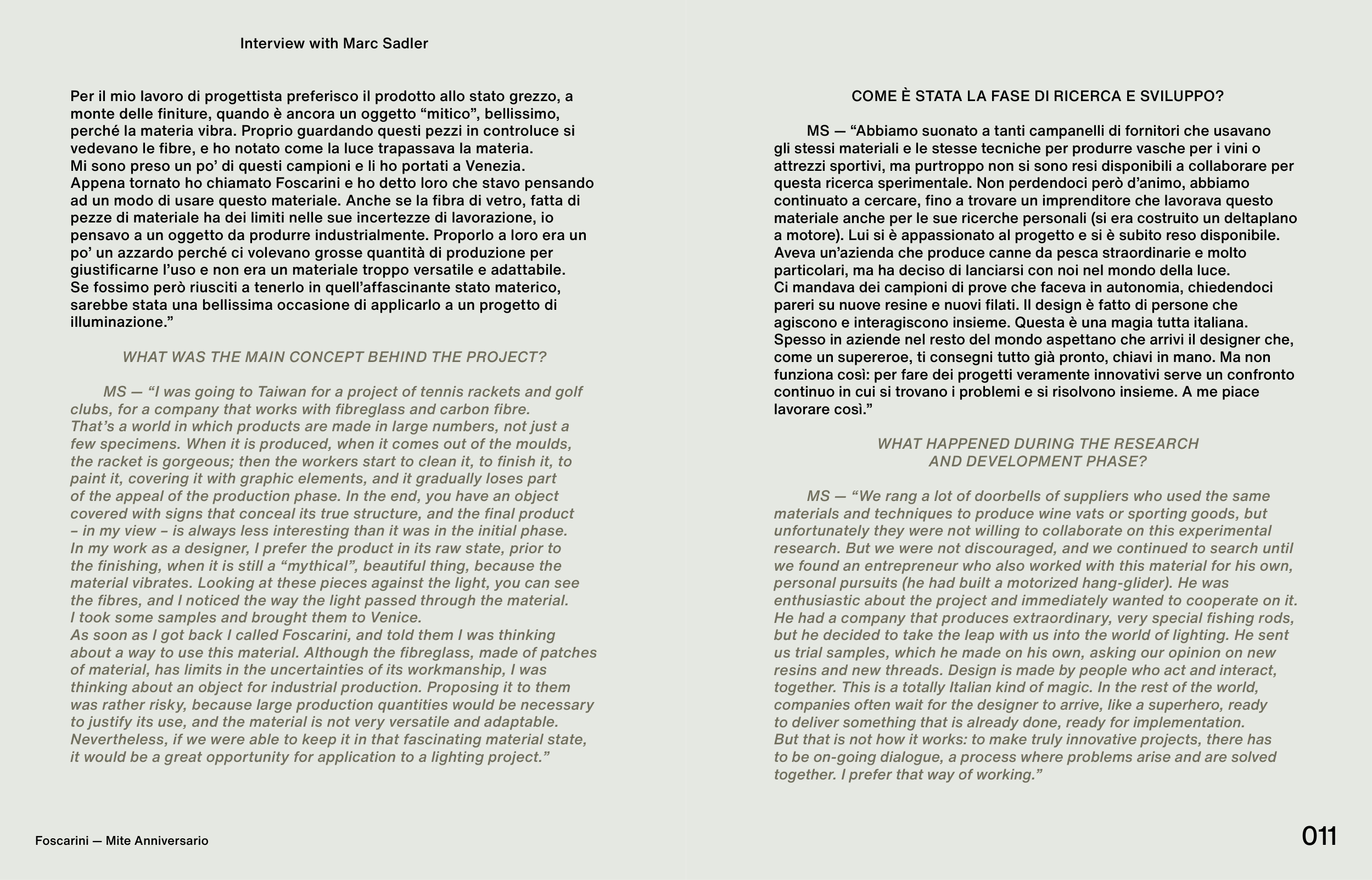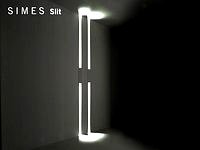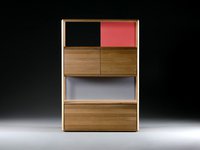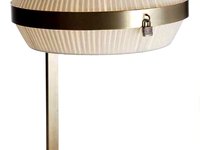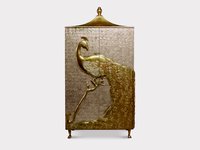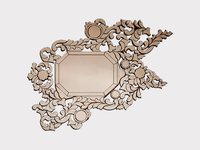011
Interview with Marc Sadler
Per il mio lavoro di progettista preferisco il prodotto allo stato grezzo, a
monte delle finiture, quando è ancora un oggetto “mitico”, bellissimo,
perché la materia vibra. Proprio guardando questi pezzi in controluce si
vedevano le fibre, e ho notato come la luce trapassava la materia.
Mi sono preso un po’ di questi campioni e li ho portati a Venezia.
Appena tornato ho chiamato Foscarini e ho detto loro che stavo pensando
ad un modo di usare questo materiale. Anche se la fibra di vetro, fatta di
pezze di materiale ha dei limiti nelle sue incertezze di lavorazione, io
pensavo a un oggetto da produrre industrialmente. Proporlo a loro era un
po’ un azzardo perché ci volevano grosse quantità di produzione per
giustificarne l’uso e non era un materiale troppo versatile e adattabile.
Se fossimo però riusciti a tenerlo in quell’affascinante stato materico,
sarebbe stata una bellissima occasione di applicarlo a un progetto di
illuminazione.”
WHAT WAS THE MAIN CONCEPT BEHIND THE PROJECT?
MS — “I was going to Taiwan for a project of tennis rackets and golf
clubs, for a company that works with fibreglass and carbon fibre.
That’s a world in which products are made in large numbers, not just a
few specimens. When it is produced, when it comes out of the moulds,
the racket is gorgeous; then the workers start to clean it, to finish it, to
paint it, covering it with graphic elements, and it gradually loses part
of the appeal of the production phase. In the end, you have an object
covered with signs that conceal its true structure, and the final product
– in my view – is always less interesting than it was in the initial phase.
In my work as a designer, I prefer the product in its raw state, prior to
the finishing, when it is still a “mythical”, beautiful thing, because the
material vibrates. Looking at these pieces against the light, you can see
the fibres, and I noticed the way the light passed through the material.
I took some samples and brought them to Venice.
As soon as I got back I called Foscarini, and told them I was thinking
about a way to use this material. Although the fibreglass, made of patches
of material, has limits in the uncertainties of its workmanship, I was
thinking about an object for industrial production. Proposing it to them
was rather risky, because large production quantities would be necessary
to justify its use, and the material is not very versatile and adaptable.
Nevertheless, if we were able to keep it in that fascinating material state,
it would be a great opportunity for application to a lighting project.”
COME È STATA LA FASE DI RICERCA E SVILUPPO?
MS — “Abbiamo suonato a tanti campanelli di fornitori che usavano
gli stessi materiali e le stesse tecniche per produrre vasche per i vini o
attrezzi sportivi, ma purtroppo non si sono resi disponibili a collaborare per
questa ricerca sperimentale. Non perdendoci però d’animo, abbiamo
continuato a cercare, fino a trovare un imprenditore che lavorava questo
materiale anche per le sue ricerche personali (si era costruito un deltaplano
a motore). Lui si è appassionato al progetto e si è subito reso disponibile.
Aveva un’azienda che produce canne da pesca straordinarie e molto
particolari, ma ha deciso di lanciarsi con noi nel mondo della luce.
Ci mandava dei campioni di prove che faceva in autonomia, chiedendoci
pareri su nuove resine e nuovi filati. Il design è fatto di persone che
agiscono e interagiscono insieme. Questa è una magia tutta italiana.
Spesso in aziende nel resto del mondo aspettano che arrivi il designer che,
come un supereroe, ti consegni tutto già pronto, chiavi in mano. Ma non
funziona così: per fare dei progetti veramente innovativi serve un confronto
continuo in cui si trovano i problemi e si risolvono insieme. A me piace
lavorare così.”
WHAT HAPPENED DURING THE RESEARCH
AND DEVELOPMENT PHASE?
MS — “We rang a lot of doorbells of suppliers who used the same
materials and techniques to produce wine vats or sporting goods, but
unfortunately they were not willing to collaborate on this experimental
research. But we were not discouraged, and we continued to search until
we found an entrepreneur who also worked with this material for his own,
personal pursuits (he had built a motorized hang-glider). He was
enthusiastic about the project and immediately wanted to cooperate on it.
He had a company that produces extraordinary, very special fishing rods,
but he decided to take the leap with us into the world of lighting. He sent
us trial samples, which he made on his own, asking our opinion on new
resins and new threads. Design is made by people who act and interact,
together. This is a totally Italian kind of magic. In the rest of the world,
companies often wait for the designer to arrive, like a superhero, ready
to deliver something that is already done, ready for implementation.
But that is not how it works: to make truly innovative projects, there has
to be on-going dialogue, a process where problems arise and are solved
together. I prefer that way of working.”
Foscarini — Mite Anniversario


